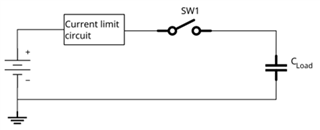Other Parts Discussed in Thread: TPS1685,
Tool/software:
Hi E2E
I’m working on designing a current limit circuit for the schematic below and would appreciate advice on selecting the optimal IC and circuit for this application.

The power source is a 48V battery capable of delivering hundreds of amps, with the load consisting of a motor driver and other high-capacitance equipment.
To avoid the battery’s BMS from shutting off due to inrush current, the current limiter must effectively control inrush when SW1 closes.
Notably, SW1 can be activated at any time. The design of the application prevents me from changing the order of the current-limit circuit and SW1.
Application Requirements
- Battery Voltage Range (VBat): 42V – 57V
- Maximum Load Current: 20A
- Inrush Current Limit (BMS): 100A for 1ms
- Maximum Capacitive Load: 10,000 µF
- Maximum in-rush char time: 1sec
I've been evaluating the TPS249x series of hot-swap controllers for this purpose. However, I’m uncertain if it’s the ideal choice for this circuit. Since the current limiter is always connected to the battery, it remains active even when SW1 is open. When SW1 closes, the current limiter wouldn’t engage in a startup sequence but may shut down due to the high inrush current.
I’d appreciate any advice on whether the TPS249x series is the best fit here, or if there might be a more suitable approach using a different technique than hot swap controllers.
Thank you in advance for your recommendations and ideas.
Best regards,
Sam

